How to understand coffee roasting in a simple way
Before I started, I had no idea what baking was. It was not until I had been a barista for many years that I realized how important coffee roasting is to the quality of coffee. Except for practitioners, the average coffee lover usually knows very little about roasting. Today, let me give you a brief introduction to coffee roasting. I won't go into too much detail, and I don't have enough knowledge to talk about it here, so if you're really interested in baking, I recommend you read The Coffee Roaster's Companion by Scott Rao.
I have been engaged in baking for 2 years, and my biggest feeling in the past 2 years is that baking is really complicated. From the history of coffee development, boutique roasting is still in its infancy, and its development is only equivalent to that of the red wine brewing industry a hundred years ago. That's why baking has become more interesting, there are too many things to be discovered, there are too many inconclusive things, and even the opinions of experts have not been unified. in my opinion, no matter what kind of baking theory, what suits you is the best. each roaster has its own unique style, and each can bake high-quality coffee.
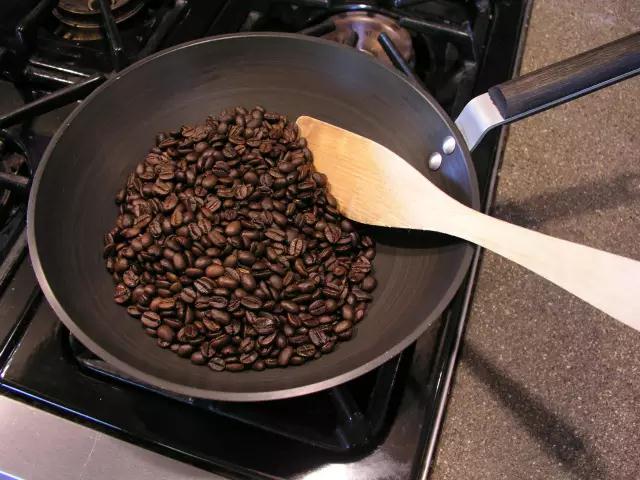
On the basic principle of baking furnace
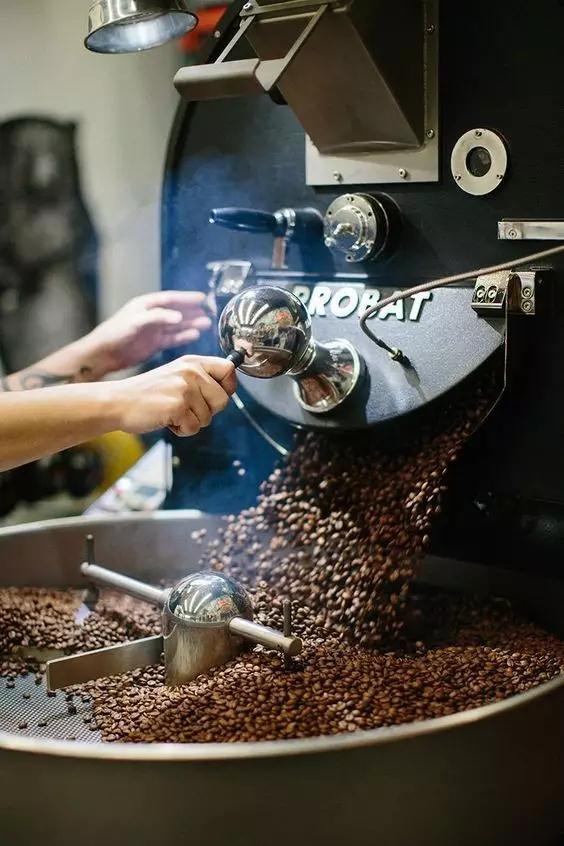
Let's start with the simplest. First, you need to pour the raw beans into the bean bin at the top of the baking oven, then push the lever or button, and the beans will fall into the stove, and the stove, like the washing machine, will keep spinning to make sure the beans are baked evenly. Under the stove is the gas stove, which is used to heat the air inside and outside the furnace. during the baking process, you can control the temperature in the furnace by adjusting the size of the fire. Hot air is constantly blown into the furnace by an electric fan, and then flows out through the flue, the speed of air flow can be controlled, this is commonly known as "airflow". After baking, the beans will enter the cooling plate, and people will use electric fans to quickly cool the beans that have just come out of the oven.
Understand the basic baking curve
Every time we train newcomers, we will tell them what happened in the baking process. I often compare the baker to the cook in my lectures. To put it bluntly, it means stir-frying, which is sure to be tasted after stir-frying and adjusted in time when there are problems, and the baking curve is like a recipe, such as the picture below.
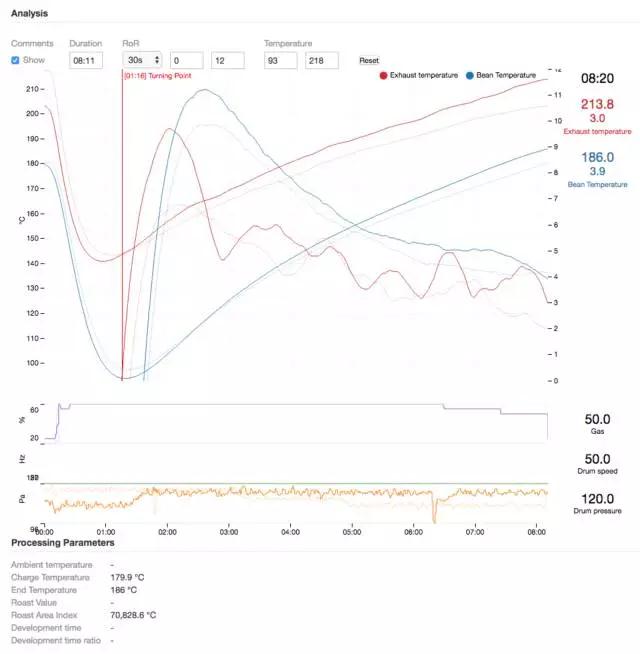
How's it going? are you dizzy? There are two curves in the picture, red and blue. The blue curve is the furnace temperature, that is, the "bean temperature", while the red curve is the temperature of the air when it flows out of the flue, that is, the "air temperature". The values of the two temperature curves are reflected on the left longitudinal axis in ℃. The blue curve reflects the rate at which the bean temperature is rising, which can help us control the furnace temperature, and the value is taken every 30 seconds, so the "+ 3.9" shown on the right means that the bean temperature rises by 3.9 ℃ every 30 seconds. The red curve reflects the heating rate of the air flow, and the value and reading method are the same as the blue curve. Other lighter curves can be ignored for the time being.
Several aspects to consider when creating a baking curve
There are many things to consider when creating a baking curve, the most important of which is bean density and water content. You need to determine the furnace temperature, and to determine the furnace temperature, we need to first in-depth understanding of the density and water content of raw beans, different coffee producing areas are different, the growth climate is also different, growing coffee with higher altitude is slower due to lower temperature; the slower the growth, the greater the density of beans; the greater the density of beans, the more difficult it is for heat to enter the inside of the bean body, so the furnace temperature needs to be higher. The ideal water content of raw beans is 10-11%, but it is usually between 8-11%. Water is a good heat conductor, so the higher the water content of raw beans, the higher the temperature the beans can withstand.
When the raw beans have just entered the furnace, the temperature of the furnace will first drop because the beans themselves are at room temperature. When the furnace temperature stops decreasing and rises, we enter the "temperature turning point". At this time, you need to strictly control the temperature in the furnace. The "temperature turning point" should occur when the beans enter the furnace for about 60-90 seconds. We can also clearly see this change in the temperature from the curve above. The blue curve shows that it decreases to the lowest and begins to rise. The rate of temperature rise determines the overall quality of baking.
The beans turn yellow
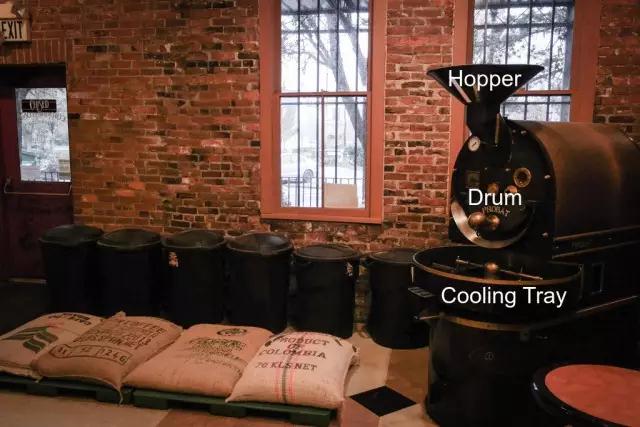
The beans begin to change when the temperature reaches about 150 ℃, when the "Maillard reaction" begins to take place in the beans, which is the key to determining whether coffee can eventually release all the essential elements.
An explosion
"an explosion" means that the bean body bursts in the furnace. Due to the continuous release of carbon dioxide and water vapor, the pressure inside the bean body rises suddenly, the bean begins to swell and the weight begins to lose, which is like making popcorn. After the explosion, the heating condition inside the bean body is very important. if the internal heating is uneven, the coffee will have the smell of green grass; if it is heated evenly, the coffee will have a charming fruit flavor! The internal heating process should account for about 20% of the total baking time.
Finally, we need to pour the roasted coffee into the cooling tray and use the fan to cool it quickly. At this time, the coffee beans are like boiled eggs. If the inside of the beans is not cooled enough, the baking of the beans will continue. As a result, the coffee will have a strong roasting flavor and a light taste.
This is the whole process of baking. To sum up, we need to make sure that the final temperature, baking time and heat of the coffee are properly mastered in order to ensure that the coffee is not charred.
After baking, we need to taste the coffee to see if the coffee has reached the best level and whether there is room for improvement in order to better improve the quality of the coffee in the future.
Important Notice :
前街咖啡 FrontStreet Coffee has moved to new addredd:
FrontStreet Coffee Address: 315,Donghua East Road,GuangZhou
Tel:020 38364473
- Prev

Misunderstanding: why does the coffee we drink taste sour?
In recent years, more and more people like to drink coffee, and they also know more and more about the taste, aroma and taste of coffee. In the past, we must have often heard the older generation say: coffee must not be sour! Coffee is shoddy as long as it is sour! Or something like that. Of course, from the current point of view, sour coffee = shoddy coffee has long been an impractical and incorrect concept.
- Next
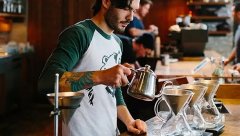
Why do more and more people like making coffee by hand?
When you walk into the cafe, the barista kindly asks you if you want to drink Italian or hand flush? Looking up at the menu, in addition to the familiar latte, cappuccino and so on, I found that there was an extra column of hand-made coffee next to it. What is Italian style and what is hand punch? What are the utensils of different shapes on the bar for? Kenya, Guatemala, Ethiopia Yega
Related
- Beginners will see the "Coffee pull flower" guide!
- What is the difference between ice blog purified milk and ordinary milk coffee?
- Why is the Philippines the largest producer of crops in Liberia?
- For coffee extraction, should the fine powder be retained?
- How does extracted espresso fill pressed powder? How much strength does it take to press the powder?
- How to make jasmine cold extract coffee? Is the jasmine + latte good?
- Will this little toy really make the coffee taste better? How does Lily Drip affect coffee extraction?
- Will the action of slapping the filter cup also affect coffee extraction?
- What's the difference between powder-to-water ratio and powder-to-liquid ratio?
- What is the Ethiopian local species? What does it have to do with Heirloom native species?

